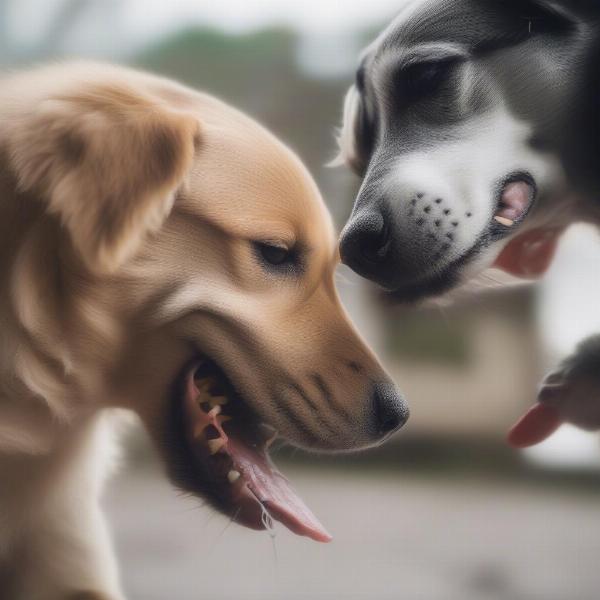The term “dog pyramid” often sparks curiosity among dog owners. It represents a simplified visual of how dogs perceive social structures, sometimes mistakenly interpreted as a strict hierarchy. Understanding this concept helps owners navigate multi-dog households and interpret canine interactions more effectively. This article will delve into the complexities of the dog pyramid, debunking common myths and providing practical advice for fostering harmonious relationships between dogs living under the same roof.
Is There Really a Dog Pyramid?
While a rigid, pyramid-shaped hierarchy rarely exists in dog households, there’s definitely a social structure. Think of it less like a pyramid and more like a fluid network of relationships, constantly adapting based on individual personalities, experiences, and resources. Dominance, often associated with the dog pyramid, is not a fixed personality trait. It’s context-specific, meaning a dog might be “dominant” over food but submissive when playing. This dynamic interplay makes each dog-dog relationship unique.
 Dogs interacting during playtime
Dogs interacting during playtime
Factors Influencing Canine Social Dynamics
Several factors influence the social dynamics within a dog group. Age, size, and breed can play a role, but temperament and learned experiences are often more significant. A confident, smaller dog might assert itself over a timid, larger dog. Early socialization plays a crucial role; puppies exposed to various dogs and social situations develop better communication skills and adapt more easily to multi-dog environments. Resource availability, such as food, toys, and even owner attention, can also influence interactions, with some dogs displaying possessive behaviors.
Misinterpreting the Dog Pyramid: Common Myths
The concept of the dog pyramid often leads to misconceptions. One common myth is that the “alpha” dog rules with an iron paw. In reality, healthy canine relationships are based on mutual respect and clear communication, not brute force. Another misconception is that owners need to establish themselves as the “pack leader” through dominance-based training methods. Modern dog training emphasizes positive reinforcement and building a relationship based on trust and cooperation, not fear or intimidation.
Creating Harmony in a Multi-Dog Household
Understanding canine social dynamics is key to creating a peaceful multi-dog home. Provide each dog with their own space and resources, like separate feeding bowls and beds, to minimize competition. Supervise interactions, especially during mealtimes and playtime, and intervene if necessary to prevent conflicts. Reward positive interactions with praise and treats. Consult a certified dog trainer or behaviorist if you observe persistent tension or aggression between your dogs. Their expertise can help identify the root cause of the issues and develop a tailored behavior modification plan.
Recognizing Signs of Stress and Anxiety
It’s crucial to recognize signs of stress or anxiety in your dogs. These can include excessive panting, yawning, whale eye (showing the whites of their eyes), tucked tail, lip licking, and avoidance behaviors. If you observe these signs, separate the dogs and address the underlying cause of the stress. Remember, a harmonious multi-dog household requires patience, observation, and a commitment to understanding your dogs’ individual needs and communication styles.
Conclusion
The “dog pyramid” is a simplified representation of complex canine social dynamics. By understanding these nuances, focusing on positive reinforcement training, and prioritizing each dog’s individual needs, we can foster harmonious relationships and create a happy home environment for all our canine companions. Remember, a peaceful multi-dog home isn’t about establishing dominance but about facilitating cooperation and mutual respect.
FAQ
-
Do dogs always follow a strict hierarchy? No, dog social structures are more fluid and dynamic than a rigid hierarchy.
-
How can I introduce a new dog to my existing dog? Introduce them gradually in a neutral location, allowing them to sniff and interact under supervision.
-
What should I do if my dogs fight over resources? Provide separate resources and supervise mealtimes. Consult a trainer if the problem persists.
-
Is it normal for dogs to have occasional disagreements? Yes, minor disagreements are normal. However, persistent aggression requires professional intervention.
-
How can I tell if my dog is stressed in a multi-dog household? Look for signs like excessive panting, yawning, tucked tail, and avoidance behaviors.
-
What are some common misconceptions about dog dominance? One common misconception is that owners need to be the “alpha.” Modern training focuses on positive reinforcement and building a relationship based on trust.
-
How can I promote positive interactions between my dogs? Reward positive interactions with praise and treats, provide individual space and resources, and supervise play sessions.
Related Articles
Unfortunately, there are no related articles on ILM Dog currently.
About ILM Dog
ILM Dog (ilmdog.com) is your go-to resource for expert advice on all things dog-related. We offer practical guidance on dog breeds, health care, training, nutrition, grooming, and much more. Whether you’re a first-time owner or a seasoned dog lover, ILM Dog provides the reliable information you need to ensure your furry friend thrives. Contact us at [email protected] or +44 20-3965-8624 for personalized support.